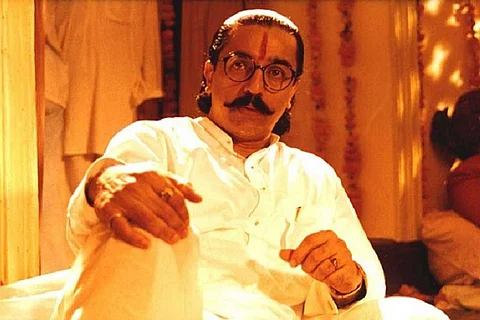

I was doing a course in journalism and mass communication at the Madras Christian College in 1999-2000 when I saw Hey Ram at Chennai’s well-known Devi Theatres. Ever since, I have been torn between feelings of love and hate for this much-hyped movie.
Hey Ram was released in Februrary 2000. My quarrels were mostly about sex and violence. For instance, the scene in which Aparna (Rani Mukerji) is sexually assaulted and left to die by Altaf, the Muslim tailor, was horrifying. The subsequent sequence through the streets of Kolkata as Saket Ram (Kamal Haasan) goes on a rampage of revenge is also harrowing to watch. The portrait of the Kolkata (then Calcutta) riots included scenes in which Muslims were slaughtered by Hindus and Sikhs. The central rape scene of the initial portion and its aftermath have exceptional sets done by art director Sabu Cyril.
There is another scene set during the riots in which Ram sees a dead mahout even as an elephant with a ‘namam (caste mark)’ has survived. Kamal’s cleverness in crafting the screenplay is apparent. The first 45-minutes of the movie has Ram leaving his archaeological site (Harappa and Mohenjadaro) along with his close friend, Amjad Ali Khan, played by Shah Rukh Khan. The duo is forced to leave the site due to the threat of India being divided during a possible partition.
The film was distributed in Hindi by SRK’s Red Chillies Entertainment. The film chronicles an alternate history of an India which is divided and the Mahatma assassinated by Nathuram Godse. Kamal plays Saket Ram who is assigned the task of killing Gandhi but makes a last-minute decision to abandon his effort. The film starts with a black and white sequence set in 1999, when a doctor played by Abbas desperately tries to save Ram’s life even as he chats with Ram’s writer-grandson.
Kamal, who directed the film, besides overseeing most departments, inspires us with attention to detail. He freely mixes facts with fiction, which was entirely new to Tamil cinema. There is even mention of a new book in which the author (Saket Ram’s grandson) plans to mix biography with fiction. The movie has this evergreen nature, which makes you think that it would have done well if it had released every year since 2000. Back then, people were grumbling during all the difficult-to-understand portions. The English dialogues too came in for some criticism.
After the archaeological expedition is tragically stalled, the team returns to Karachi, where they gather at a posh club. After a mandatory song sequence, Kamal goes home to Kolkata where the aforementioned riots take place. Atul Kulkarni, who won the National Award for Best Supporting Actor for this movie, plays Shriram Abhayankar, an early influence on Ram’s hatred towards Gandhi. It’s Abhayankar, the ideologue, who takes Ram under his wing and schools him on the politics of the day. They meet each other twice during the riots.
We cut to Srirangam, where Ram marries, a second time, Mythili, played by Vasundhara Das. But incidents during the riots continue to haunt Ram and he fails to consummate their marriage. Soon enough, Mahatma Gandhi makes the much-awaited appearance. The interaction leaves Gandhi happy and Ram unsatisfied. Ram’s marriage with Mythili is slow to catch fire. Vasundhara Das is cast as an intelligent woman grappling with an absurd man and his curious eccentricities. When Ram finally 'ravishes' her -- and there is really no other word for it -- he already has been assigned the daunting task of killing Gandhi.
Kamal, as director, goes to extreme lengths to combine the sexual and violent aspects of this angle to the screenplay. Between all of this, there is a certain extent of pandering to the voyeurs in the audience. During some of these occasions, like when Mythili hugs Ram (Vasundhara hugging Kamal), we wish that there was someone else on the director’s chair to tell Kamal how far he should go.
The whole point of Hey Ram is to question Gandhi and his principles and exonerate him at the end. For the entire length of the movie, Ram believes that the Mahatma got it wrong. Plenty of us, who owe it to Gandhi for making India an independent country, speak ill of the great leader in our homes and public places. Hey Ram acts as an effective antidote to this grumbling and private dissatisfaction. Gandhi is perhaps the last great political leader we had. That’s why no one is able to touch him. That’s also why Hey Ram, for all its faults, is more important to us now than any other time in history.
Views expressed are author's own.
Nandhu Sundaram is a film critic and freelance journalist who lives in a village situated in the back of beyond in Kanyakumari district. He loves cricket and is trying his hand at short stories. He has a seven-year-old daughter.